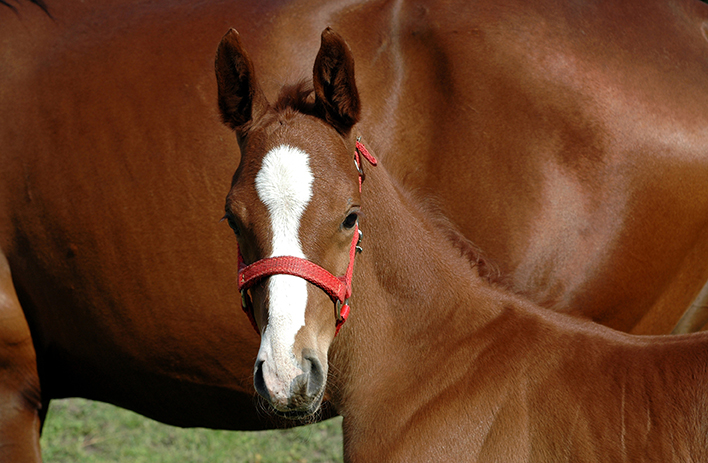
The male parent of a horse, a stallion, is commonly known as the sire and the female parent, the mare, is called the dam. Both are genetically important, as each parent provides half of the genetic makeup of the ensuing offspring, called a foal. Contrary to popular misuse, "colt" refers to a young male horse only; "filly" is a young female. Though many horse owners may simply breed a family mare to a local stallion in order to produce a companion animal, most professional breeders use selective breeding to produce individuals of a given phenotype, or breed. Alternatively, a breeder could, using individuals of differing phenotypes, create a new breed with specific characteristics.
A horse is "bred" where it is foaled (born). Thus a foal conceived in England but foaled in the United States is regarded as being bred in the US. In some cases, most notably in the Thoroughbred breeding industry, American- and Canadian-bred horses may also be described by the state or province in which they are foaled. Some breeds denote the country, or state, where conception took place as the origin of the foal.
Similarly, the "breeder", is the person who owned or leased the mare at the time of foaling. That individual may not have had anything to do with the mating of the mare. It is important to review each breed registry's rules to determine which applies to any specific foal.
In the horse breeding industry, the term "half-brother" or "half-sister" only describes horses which have the same dam, but different sires. Horses with the same sire but different dams are simply said to be "by the same sire", and no sibling relationship is implied. "Full" (or "own") siblings have both the same dam and the same sire. The terms paternal half-sibling, and maternal half-sibling are also often used. Three-quarter siblings are horses out of the same dam, and are by sires that are either half-brothers (i.e. same dam) or who are by the same sire.
Thoroughbreds and Arabians are also classified through the "distaff" or direct female line, known as their "family" or "tail female" line, tracing back to their taproot foundation bloodstock or the beginning of their respective stud books. The female line of descent always appears at the bottom of a tabulated pedigree and is therefore often known as the bottom line. In addition, the maternal grandfather of a horse has a special term: damsire.
"Linebreeding" technically is the duplication of fourth generation or more distant ancestors. However, the term is often used more loosely, describing horses with duplication of ancestors closer than the fourth generation. It also is sometimes used as a euphemism for the practice of inbreeding, a practice that is generally frowned upon by horse breeders, though used by some in an attempt to fix certain traits.
Breeding - Click the Name
Breeding - General Information
- Anne Peters, Pedigree Goddess
- Equineline.com
- FoalPhotos.com
- Indian Stud Book
- International Federation of Horseracing Authorities
- Japanese Stud Book
- Korean Stud Book
- New Zealand Stud Book
- Pam Shaughnessy, Thoroughbred Data Specialist
- Pedigree Query
- Stallion eSearch
- Stallions Now, 345 S. Coast Hwy 101, Ste M2, Encinitas, CA, 92024
- Stud Book Argentino
- Stud Book Brasileiro
- The Blood Horse
- Thoroughbred Information Agency, P.O. Box 102, Sierra Madre, California 91025
- Weatherbys Stud Book

- American Quarter Horse Association, 1600 Quarter Horse Drive, Amarillo, TX 79104
- Arizona Thoroughbred Breeders Association (ATBA), 1501 W. Bell Road, Phoenix, AZ 85023
- Arkansas Thoroughbred Breeders' and Horsemen's Association
- California Thoroughbred Breeders Association, P.O. Box 60018, Arcadia, CA 91066-6018
- Delaware Standardbred Breeders' Fund (DESBF), Delaware Dept of Agriculture, 2320 S. DuPont Hwy., Dover, DE 19901
- Florida Standardbred Breeders' & Owners' Association, 1800 SW 3rd Street, Pompano Beach, FL 33069
- Florida Thoroughbred Breeders' & Owners' Association, 801 S.W. 60th Avenue, Ocala, FL 34474
- Idaho Quarter Horse Association (IQHA), 517 South 10th Ave., Caldwell, ID 83605
- Idaho Thoroughbred Association, Inc., P.O. Box 140311, Boise, ID 83714
- Iowa Thoroughbred Breeders and Owners Association (ITBOA), One Prairie Meadows Drive, Altoona, IA 50009
- Kentucky Quarter Horse Association, P.O. Box 23917, Lexington, KY 40523-3917
- Louisiana Quarter Horse Breeders Association, P.O. Box 12300, Alexandria, LA 71315
- Louisiana Thoroughbred Breeders Association, 1751 Gentilly Blvd., New Orleans, LA 70119
- Maryland Horse Breeders Association, P.O. Box 427, 30 East Padonia Road, Suite 303, Timonium, MD 21094
- Maryland Standardbred Breeders Association, 28722 Waller Road, Delmar, MD 21875
- Michigan Harness Horsemen's Association (MHHAA), 2501 Jolly Road, Suite 110, Okemos, MI 48864
- Minnesota Thoroughbred Association, 1100 Canterbury Road, Shakopee, MN 55379
- Nebraska Thoroughbred Breeders Association (NTBA), NTBA, P.O. Box 2215, Grand Island, NE 68802
- New Mexico Horse Breeders Association, P.O Box 36869, Albuquerque, NM 87176
- New York State Thoroughbred Breeding & Development Fund Corporation, 1 Broadway Center Suite 601, Schenectady, New York 12305
- New York Thoroughbred Breeders, Inc., 57 Phila Street, Saratoga Springs, NY 12866
- New Zealand Standardbred Breeders Association, HRNZ Building, 135 Lincoln Road, Addington, Christchurch NZ
- Pennsylvania Horse Breeders Association, 701 East Baltimore Pike, Suite E, Kennett Square, PA 19348
- South Carolina Thoroughbred Owners & Breeders Association (SCTOBA), 3506 Qualla Road, Hayesville, NC 28904
- Standardbred Breeders & Association of New Jersey, 64 Business Route 33, Manalapan, NJ 07726
- Standardbred Breeders Association of Pennsylvania, 2310 Hanover Pike, P.O. Box 339, Hanover, PA 17331
- Thoroughbred Owners and Breeders Association (TOBA) P.O. Box 910668, Lexington, KY 40591
- Washington Thoroughbred Breeders & Owners Association, 3220 Emerald Downs Dr., Auburn, WA 98001
Pedigree Theories and Selection Techniques: Nick Ratings
Nick Ratings (or why nick ratings are the bane of my existence), by Anne Peters
It's important that people understand what a nick is, and the difference between a nick and a nick rating. Nicks are a fact, but nick ratings are a statistic, and we all know statistics can be very misleading. Unfortunately, ratings are what people want nowdays because it's easier to read a score and blindly accept it, than to reason out the intricate process of properly mating your mare.
The word "nick" has become distorted in breeding jargon due to the proliferation of the ratings, so that many people have come to use it as a verb. "What stallions nick with my mare?" or "I want you to nick my mares." When I hear that, my skin crawls. The nick ratings have created this quick and dirty method of matching stallions and mares to the demise of well rounded matings.
I don't think this is what the creators of either popular nick rating system intended, but that's what has happened. Nick ratings have done more to take down real mating analysis than anything I've ever seen.
What is a nick? In my article "Nicks or Not," I explain that a nick is a real live genetic term describing a cross of two bloodlines that produces superior results a surprising amount of the time. It's not guaranteed, but it has a serious track record. The A.P. Indy/Mr. Prospector cross is a good modern example.
Some of A.P. Indy's most important offspring are the result of this nick including Horse of the Year Mineshaft, and his good sire sons Pulpit and Malibu Moon, all sons of A.P. Indy out of mares sired by Mr. Prospector. That's a nick. It's rare, and it's very specific.
A.P. Indy on a mare by Mr. Prospector represents a very specific pedigree alignment accounting for 75% of the same pedigree on paper. If the mare is not by Mr. Prospector, we're not talking about the same nick. Bernardini is by A.P. Indy and out of a mare by Quiet American.
Quiet American, by Fappiano, by Mr. Prospector, is a male line grandson of Mr. Prospector. It's a similar cross, but technically, it's not the same nick, because Mr. Prospector's influence is diluted 2 generations further back.
Since we know full siblings in actuality share only about 50% of their genes, theoretically, the chances of genetic similarity based on three-quarter relatives, relatives with 75% similar parentage, are half of that, or 37.5%.
A.P. Indy crossed with a mare by a son of Mr. Prospector reduces the influence of Mr. Prospector by even more, down to 62.5% on paper, or 31.25% in terms closer to probability. The further back the key ancestor is along the mare's male line, it's potential influence decreases dramatically every generation.
































